News
Killings send shudders thru Kilinochchi
Once a bustling farming village, the northern town of Kilinochchi was the heartland of the Liberation Tigers of Tamil Eelam (LTTE) during the near three-decade long separatist war. It is here that Tiger leader Velupillai Prabhakaran and his family spent time in secret hideouts, at least one with a swimming pool and other luxuries. It was the nerve centre of a virtual parallel government.
The separatist guerillas’ military defeat in May 2009 saw the dawn of a new era – green paddyfields and vegetable plots grew again around Kilinochchi and it has become a bustling township with government officials and a burgeoning centre for small traders.
Now, however, memories of the war years have been ignited with police and security forces launching a manhunt to unravel the mystery of the killing of two police constables in the sleepy village of Vavunativu, near the centre of Batticaloa.
Dinesh Algaratnam, 28, from the Kalmunai area, and Niroshan Indika, 35, a father of one from Udugama in Galle, were killed at dawn while on duty at a police checkpoint in a desolate spot in Vavunativu on November 29. Their hands were bound. They were shot and had multiple lacerations. Both men had been armed with service revolvers which have not been found.
Vavunativu, dotted with small villages and surrounded by the lagoon and waterways, lies few kilometers south of the Batticaloa Police Station.
The 30,000 residents of the suburb of Manmunai West, where the incident took place, make their livelihood mainly through paddy cultivation and fishing.
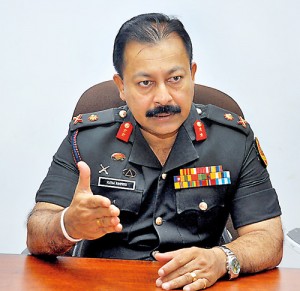
Major-General Ravipriya
On Thursday, November 29, the two police officers were stationed at a checkpoint at the southern entry to the Vavunativu bridge on the Karaveddy-Manmunai West road that leads to Batticaloa airport, a few kilometers away.
The checkpoint, made mostly of corrugated roofing sheets, has no modern facilities, just a plastic water tank donated by an international organisation. Nearby is a small bo-tree with a worship area.
The incident shocked the security establishment. Both constables were posthumously promoted to the rank of sergeant.
There was widespread speculation on the resurgence of the terrorists. As events unfolded in the following days these fears were laid to rest but police suspicions settled on a few ex-LTTE cadre.
The backdrop of the incident was “Maveerar Day” (Great Heroes’ Day) which commemorates the LTTE dead.
Police prohibited public displays of slain LTTE leader Vaillupillai Prabhakaran’s picture, LTTE flags and the like, visiting villages to ask people not to display the banned images and flags.
Despite this, some decorations and monuments were erected. Police removed some, infuriating the sponsors, all former LTTE cadre.
Two suspects have been arrested over the shooting of the two police officers; one, Rasanayagam Sarvendran, 48, is a resident of Kilinochchi.
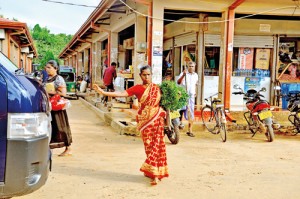
The bustling main market in Kilinochchi town. Pix by Priyantha Wickramaarachchi
Both suspects are being questioned under a detention order issued under the Prevention of Terrorism Act (PTA). A CID team team is still on the ground in Batticaloa. A jacket used by one of the suspects was found by a Police K9 team last week although no weapons have yet been recovered.
Police have questioned 18 people, mostly former LTTE activists who have been through the rehabilitation process. There is a heavy police presence in Batticaloa with buildings searched and vehicles checked in the Vavunativu area.
In Kilinochchi, the situation on the ground seems calm as the public hurry about their day-to-day business. As in many townships across the country, the Sunday Times heard complaints about the lack of development, investment and employment opportunities. The citizens seem to be busy with their own livelihood battles.
Residents were baffled about what transpired in Vavunativu and none we spoke to voiced support for the LTTE – in fact, many wanted to move on from wartime memories and recoiled from rumours of a revival of terrorist activity.
“We are closely monitoring the police investigation,” said Major-General Vijitha Ravipriya, General Officer Commanding (GOC) of the 57th Division, when asked about Rasanayagam Sarvendran’s arrest.
“We must not overreact and jump to conclusions. We need to let the investigation run its course,” he said, adding that the murders were an isolated incident.
“We have built up links with grassroots leaders in the community. The army has built up trust with the population,” Major-General Ravipriya explained, pointing out that the army had changed strategies from yesteryear’s highly-visible armed presence on the streets. The army is more approachable, he said.
“We are building a public-oriented relationship with the aim of fostering development and reconciliation while being vigilant.
“As soon as there is any suspicious activity, the message reaches us,” Major-General Ravipriya said. “We have not found any rogue LTTE elements or any other such groups in our area of responsibility.”

Schoolboys in jubilant mood on last day of O/Levels
The commander asserted the trust between the public, administrative stakeholder and the military in Kilinochchi was paying off.
He said the military kept a close eye on ex-LTTE cadre, explaining that a major obstacle in successfully reintegrating them back to society was their general lack of skills and education.
“We have to help them to get basic education and skills that will help them to find employment or become entrepreneurs.”
There are 1,517 registered male ex-LTTE activists and 318 females in the Kilinochchi district. The army employs a number of them on a 120-acre farm, offering skills development and helping them find work.
“The Maveerar Day celebration took place with a number of participants but there were no emblems, flags or inflammatory speeches this year,” said a police source in Kilinochchi who wished to remain anonymous. “The attendees came and left peacefully within a few hours.”
“We have worked hard to build trust between the public and the police,” the source said. “Even if a farmer finds a piece of unexploded ordnance, ammunition or buried weapons, we are promptly notified.
“When a serious crime happens in the south of the country, most of the time a deserter from the armed forces in involved and no-one makes a big issue out of it. When a similar incident happens in the north or east there’s a similar chance that an ex-LTTE cadre is involved,” he argued, pointing out that there had been several murders of police officers and Prisons Department officers in the south in the recent past involving deserters from the armed forces.
The police officer said the biggest law enforcement problems in Kilinochchi were illegal sand-mining, illegal logging and low-level use of Kerala ganja.
He said police recruitment in the area was a challenge and wished there were more officers with local knowledge and language skills.
A fine thread of cross-racial interaction runs through the local community. R. Kumarasami, a 74-year-old vegetable vendor at the Kilinochchi market is a link between the north and the south. He speaks fluently in Sinhala and Tamil and has been delivering vegetables between the north and south for decades.
“Although there is a lot of talk about arrests we still don’t know much: no-one is giving out information,” he said when asked about the arrest of Sarvendran.
“The LTTE is in the past: our people want progress, not violence,” he said. “We are alive because the war is over.
“The LTTE took away one of my daughters – I brought her in to surrender to the authorities,” he said gesturing with his hands that he handed over his child.
Speaking about day-to-day affairs, Mr. Kumarasami said business was slow compared to last year. “One of the major problems is the drop in demand for contract workers this year, so unemployment is on the rise,” he said.
He lamented the state of government facilities in Kilinochchi, particularly in the hospitals. “We are sent from one place to another to obtain treatment. Sometimes we’re asked to go to Colombo to get certain drugs,” Mr. Kumarasami complained.
Life was not perfect but the old gentleman was content. “The people are unemployed but are living in peace,” he said.
“The deaths of two police officers is a heavy price to pay to be reminded that security should not be taken lightly and that vigilance, not panic is the need of the hour. Despite all odds the approach of the security forces and the Police has nipped in the bud the growth of rumors of a resurgence in terrorist activity.”
| Suspect went under the radar | |
| Once an LTTE instructor who trained guerillas for combat, 48-year-old Rasanayagam Sarvendran, who stands accused of killing of two policemen, went through a year’s rehabilitation programme in Welikanda when the civil war ended in 2009.After rehabilitation he returned to his village, Vattakachchi, 11km from Kilinochchi town, to settle down. Six years ago he married, and now has four children. He seemed to have left the LTTE behind. He had joined the militant movement in its very early stages and despite his lack of education – he had been in school only until Grade 8 – had risen though the ranks to be a trainer of raw recruits. Following rehabilitation, after a spell as a day labourer doing odd jobs, he had settled down to work collecting vegetables from the village and surrounding areas and transporting them to the Kilinochchi main market in a hired lorry. Military sources said Sarvendran had been monitored along with other former LTTE cadre but seemed to be socially active and no adverse reports about him had been received. His name came up in the investigation of the shooting in Batticaloa because police knew he had been involved in the LTTE commemorative programmes. Last Friday, police visited Sarvendran’s home at Wattakachchi and left a message as he was not in. On the following day, he was placed under arrest. |
| Work, not war, is needed | |
A short drive from Kilinochchi, Kumarasooriya Wimalachandran, a 42-year-old father of two, stands guard on the Iranamadu tank sluice gate. 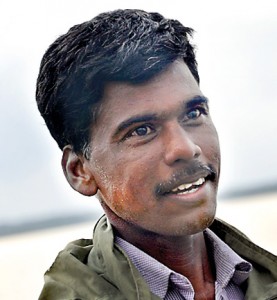 Kumarasooriya Wimalachandran The recent rains had brought much-needed water to the district and the Iranamadu tank held water to a depth of 34 feet, two feet short of overflow limit. Mr. Wimalachandran is a rehabilitated LTTE fighter employed as a security guard by a private firm. He joined the LTTE at the age of 14 and was part of its military wing in the north for 14 years. Now disabled, he showed extensive injuries sustained during the war. “Having this job is very important: it pays well,” he said, explaining that it was difficult to find permanent employment with decent wages in Kilinochchi. Following rehabilitation in October 2016, he had tried to run his own business but had been unsuccessful. Now, he said, his monthly take-home pay averaged Rs. 21,000. “We are not worried about the LTTE – that’s in the past. We need employment,” the former guerilla said. |
| LTTE return? ‘No chance!’ | |
Kaleiwani Bavandran, 35, is a former LTTE operative who now works at a farm run by the army in Kilinochchi and is a mother of two. When asked the possibility of a resurgent LTTE she responded, in English, “No chance!”. 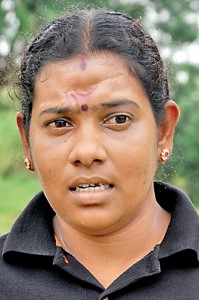 Kaleiwani Bavandran She carries a scar on her forehead from an explosion. Forcefully recruited to the LTTE during the latter stages of the war, she was assigned to nurse the injured, having been studying nursing at the time of conscription. She claims her monthly wage is comparable to that of an army soldier and the wage, wage, job security and benefits were better than a contract labourer would receive. When asked why she is not working as a nurse, Mrs. Bavandran said her course of study was not recognised by the state and it was hard to find employment in the medical sector. She would, however, like to return to nursing one day. |
| Tamil diaspora clings to bloody vision that locals reject | |
P. Kanagasivam, a vendor, who moved from Colombo to Kilinochchi in 1980, said unemployment and drought were the two main causes of concern for the local people. 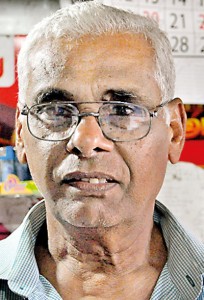 P. Kanagasivam The establishment of garment factories was a welcome addition to Kilinochchi, providing much-needed employment for many of the youth, he said. With many banks and financial institutions now operating in Kilinochchi town there was support for business as loans were available, he said. “Never again will parents allow their children to be taken by the LTTE – they saw what happened during the war,” he argued. “We need this freedom. We didn’t have that with the LTTE. “The young in Kilinochchi are not interested in the LTTE any more – they want jobs, a decent income and good lifestyle.” Mr. Kanagasivam did, however, express concern about many in the Tamil diaspora who still subscribe to the LTTE ideology. |

